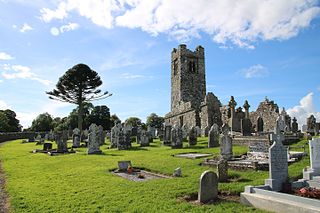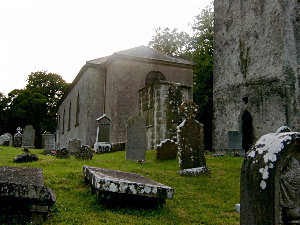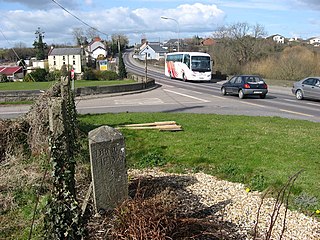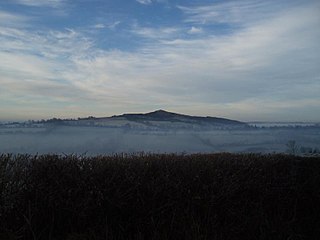
Slane is a village in County Meath, in Ireland. The village stands on a steep hillside on the left bank of the River Boyne at the intersection of the N2 and the N51. As of the 2016 census, Slane's population was 1,369. The village and surrounding area contains many historic sites dating back over 5,000 years. The village centre, as it is laid-out today, dates mainly from the 18th century.

Ardbraccan is an ancient place of Christian worship in County Meath, Ireland. It is the location of the former residence of the Roman Catholic, then, after the Reformation, the Church of Ireland Bishop of Meath. It is approximately 30 miles from Dublin.

Julianstown is a village in County Meath, Ireland. It is located near Drogheda on the R132 regional road. In 1641, the Battle of Julianstown was fought here during the Irish Rebellion of 1641.

Carnaross or Carnaros is a village in County Meath, Ireland, approximately 4 km northwest of Kells on the R147 road between Kells and Virginia, County Cavan.

Aughagower or Aghagower is a small village in rural County Mayo in western Ireland. It is located about 6 km from Westport. Aughagower has around 40 houses, 1 pub and a shop, with a clear view of Croagh Patrick from Reek View. It also forms the centre of a parish of the same name which covers an area of 86.1 square miles. The village is known for its links to Saint Patrick and Tóchar Phádraig, the pilgrimage route from Ballintubber Abbey to Croagh Patrick.

Duleek is a small town in County Meath, Ireland.

The Synod of Ráth Breasail was an Irish Catholic church council which took place in Ireland in 1111. It marked the transition of the Irish church from a monastic to a diocesan and parish-based church. Many Irish present-day dioceses trace their boundaries to decisions made at the synod.

Naul, is a village, townland, and civil parish at the northern edge of Fingal and the traditional County Dublin in Ireland. The Delvin River to the north of the village marks the county boundary with County Meath. Naul civil parish is in the historic barony of Balrothery West.

Knockeyon is a hill in County Westmeath, Ireland in the townland of Streamstown. When viewed from the Ranaghan, and Gillardstown side of the hill, it dominates the surrounding lakes in the countryside of northern County Westmeath. The chimney of the cement works in Duleek near Drogheda can be seen on a clear day due west, as well as Slieve Gullion in South Armagh and the Mourne Mountains beyond to the north east. The Hills of Mael, Curry and Mullaghmean are viewed from Knockeyon to the north west, and the Cuilcagh Mountains to the north-north-west.

Dunsany Castle, Dunsany, County Meath, Ireland is a modernised Anglo-Norman castle, started c. 1180 / 1181 by Hugh de Lacy, who also commissioned the original Killeen Castle, nearby, and the famous Trim Castle. It is one of Ireland's oldest homes in continuous occupation, possibly the longest occupied by a single family, having been held by the Cusack family and their descendants by marriage, the Plunketts, from foundation to the present day. The castle is surrounded by its demesne, the inner part of the formerly extensive Dunsany estate. The demesne holds a historic church, a walled garden, a stone farm complex, and an ice house, among other features, and is home to a wide range of fauna.

Mornington is a coastal village on the estuary of the River Boyne in County Meath, Ireland approximately 5 km downriver from the centre of Drogheda. Together with the neighbouring villages of Laytown and Bettystown it comprises the census town of Laytown-Bettystown-Mornington, with a combined population of 10,889 at the 2011 Census and 11,872 at the 2016 Census. Mornington is part of the wider area collectively known as East Meath.
St. Cianán, or Kenan, was a Bishop of Duleek in Ireland. He was descended from the royal blood of the kings of Munster. His feast day is 24 November.

Kildare Cathedral, or St Brigid's Cathedral in Kildare, is one of two Church of Ireland cathedrals in the United Dioceses of Meath and Kildare. It is in the ecclesiastical province of Dublin. Originally a Catholic cathedral, it was built in the 13th century on the site of an important Celtic Christian abbey, which is said to have been founded by Saint Brigid in the 5th century. The site was taken over by the Protestant Church of Ireland following the Reformation. There is an Irish round tower in the cathedral grounds.

The National Museum of Ireland – Archaeology is a branch of the National Museum of Ireland located on Kildare Street in Dublin, Ireland, that specialises in Irish and other antiquities dating from the Stone Age to the Late Middle Ages.

Drumlane is a townland situated near the village of Milltown, area 85.76 hectares, in County Cavan, Ireland. Drumlane is also the name of the civil parish in which the townland is situated. Saint Columba brought Christianity to Drumlane in 555, and Saint Máedóc of Ferns was the patron saint of Drumlane Abbey. Saint Máedóc made the Connachta nobleman Faircheallaigh the first Abbot of Drumlane in the 7th century and his Ó Faircheallaigh descendants were historically the Abbots of Drumlane. The name Drumlane denotes the drumlin region of low hilly ribbed moraines formed over a limestone bedrock created by the movement of glacial ice and melt water during the last ice age. Several townlands in the neighbourhood are prefixed with the word 'Drum', while several others are prefixed with the word 'Derry', which is Irish for oak.

Inis Cealtra, also known in English as Inishcaltra or Holy Island, is an island off the western shore of Lough Derg in Ireland. Now uninhabited, it was once a monastic settlement. It has an Irish round tower, and the ruins of several small churches, as well as four high crosses and a holy well. Despite the lack of population, the cemetery on this island is still in use. Coffins and mourners are transported the short distance from County Clare in small boats. Boat trips can be taken from the harbour at Mountshannon. It is conserved by the East Clare Heritage Centre.

Inagh and Kilnamona is a parish of the Roman Catholic Diocese of Killaloe in County Clare, Ireland. It is mostly coterminous with the civil parishes of Inagh and Kilnamona that lie to the west of the county town of Ennis in the ancient barony of Inchiquin. The parish contains two churches and an oratory.

Clondalkin Round Tower is an Irish round tower or cloigtheach founded by Saint Mochua, also known as Saint Cronan, and located in Clondalkin, South Dublin, Ireland. It is now a National Monument of Ireland. It's also become a museum that houses a cafe.

St. Mary's Abbey is a medieval monastery and National Monument located in Duleek, Ireland.

Killashee Round Tower is an Irish round tower that forms part of the monastic remnants of Killashee, County Kildare, Ireland. On the Record of Monuments and Places its number is KD024-003.



















